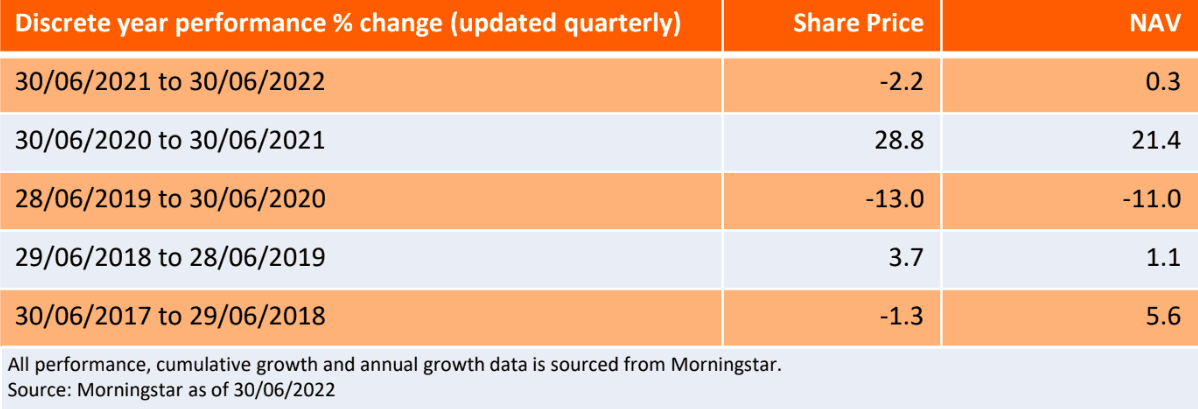Subscribe
Sign up for timely perspectives delivered to your inbox.

David Smith, Portfolio Manager of Henderson High Income Trust, provides an update on the Trust highlighting the key drivers of performance over the month of July and outlines recent portfolio activity.
The FTSE All Share Index was up by 4.4% during the month due to hopes of a slowdown in monetary policy tightening by major central banks, including the Bank of England (BoE).¹ Good corporate results provided further support. Commodity prices started to come under pressure in the month with the oil price falling below $100 per barrel for the first time since Russia’s invasion of Ukraine. Cyclical sectors performed best with financial services, retailers and industrials all outperforming, while more defensive sectors such as pharmaceuticals, tobacco and telecoms lagged.
The Trust’s net asset value (with debt at fair value) rose 6.2% during July, outperforming the FTSE All share (80%) & ML Sterling NG (20%) benchmark’s return of 4.1%.¹ Outperformance of the equity portfolio and the positive impact of gearing were the main drivers of performance.
Within the equity portfolio, the overweight positions in financials NatWest, 3i and Intermediate Capital all aided performance. NatWest announced strong results, benefiting from the recent interest rate hikes from the BoE, and a £1.75 billion special dividend.² 3i reassured with its results as its largest asset, discount retailer Action, performed robustly over the period.³ Intermediate Capital released a good trading statement with continued strong fund raisings despite increased market volatility.
Elsewhere, the fund’s holdings in non-life insurers Direct Line and Sabre detracted from returns. Both company’s warned that claims inflation in their car insurance divisions was running ahead of expectations, which would likely impact profitability for the year. Despite the disappointing share price reactions, we maintain a holding in both given our view that the market pricing environment will now likely to turn more positive and inflationary pressures should start to subside.
During the month we sold the position in Haleon, the consumer health business that demerged from GlaxoSmithKline. The company’s balance sheet seemed stretched to us and with the dividend yield low as the company prioritises debt reduction, we felt this did not fairly compensate shareholders for the elevated risks.

¹Source: Bloomberg as at 30 July 2022.
³Source: https://www.morningstar.co.uk/uk/news/AN_1658391458918200500/top-news-3i-first-quarter-robust-on-strong-performance-from-action.aspx
Glossary ExpandBalance Sheet – A financial statement that summarises a company’s assets, liabilities and shareholders’ equity at a particular point in time. Each segment gives investors an idea as to what the company owns and owes, as well as the amount invested by shareholders. It is called a balance sheet because of the accounting equation: assets = liabilities + shareholders’ equity.
Cyclical stock – Companies that sell discretionary consumer items, such as cars, or industries highly sensitive to changes in the economy, such as miners. The prices of equities and bonds issued by cyclical companies tend to be strongly affected by ups and downs in the overall economy, when compared to non-cyclical companies.
Defensive stock – A defensive stock is a stock that provides consistent dividends and stable earnings regardless of the state of the overall stock market. There is a constant demand for their products, so defensive stocks tend to be more stable during the various phases of the business cycle.
Gearing – Gearing is the measure of a companies debt level. It is also the relationship between a companies leverage, showing how far its operations are funded by lenders versus shareholders. Within investment trusts it refers to how much money the trust borrows for investment purposes.
Inflation – The rate at which the prices of goods and services are rising in an economy. The CPI and RPI are two common measures.
Monetary policy – The policies of a central bank, aimed at influencing the level of inflation and growth in an economy. It includes controlling interest rates and the supply of money. Monetary stimulus refers to a central bank increasing the supply of money and lowering borrowing costs. Monetary tightening refers to central bank activity aimed at curbing inflation and slowing down growth in the economy by raising interest rates and reducing the supply of money.
Net asset value (NAV) – The total value of a fund’s assets less its liabilities.
Volatility – The rate and extent at which the price of a portfolio, security or index, moves up and down. If the price swings up and down with large movements, it has high volatility. If the price moves more slowly and to a lesser extent, it has lower volatility. Higher volatility means the higher the risk of the investment.
Yield – The level of income on a security, typically expressed as a percentage rate. For equities, a common measure is the dividend yield, which divides recent dividend payments for each share by the share price. For a bond, this is calculated as the coupon payment divided by the current bond price.